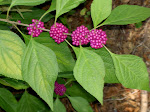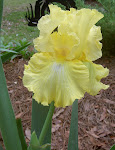Molas are made by the Cuna Indians on the San Blas Islands in Panama and are a form of "reverse applique". In the old Cuna language, the word "mola" means clothing or blouse. And most of the older molas that my father purchased when they lived in Panama in the 70's had orginally been part of a larger piece of clothing. (you could tell by the way the outside edges of the molas had pieces of loose thread from being removed from them.)
Many of the older molas were more geometrical in composition than many of the later ones--as you can see in the first photo. The next two appear to be a pair--or at least made by the same person or family members. Can you imagine hand appliqueing all of those tiny, tiny pieces? And keep in mind that these women did not have ott lights when they were sewing on that black background.
Very often, the designs of the molas reflected their culture or things that they saw in their daily lives. Sometimes it makes sense to those of us who now own their vibrant handwork and sometimes it doesn't. (A good opportunity to use one's imagination!)
This particular mola is fairly obviously taken from a poster of some sort in a presidential election. But, don't you wonder why the depiction is in the mirror image?
This was one of my favorites because my Zodiac Sign is Libra (and still is, even after the NEW signs were allocated!) And, of course, Libra stands for the scales of justice which you can see here. But, again, I wish that I could know what the artist was thinking when she made her design. Does the little cross in the top mean anything? I don't know--but I wish I did.
This mola is very "card" oriented. You can see the hearts, clubs, diamonds and spades on the hats and the word "Joker" at the top. When I visted Panama City in the 70's, there were casinos--so maybe this one has something to do with that.

 And fishing was an important part of the daily lives of a coastal culture.
And fishing was an important part of the daily lives of a coastal culture. These last two molas are modern works--very different from my older ones. My sister got these on a recent trip to Panama. From the more current molas that I've seen, it seems that the Cuna Indians still make some of the more complex designs as they did in the past, but they are also making embroiderys that will appeal to the many tourists who are now coming in on cruise ships. These new embroiderys are still beautiful--but different. Life moves on and things evolve.
Several years ago, I went to an author's luncheon in Charleston and one of the authors made a statement that has stayed with me. He said that one's Art should reflect the ground on which one stands. I think about that all the time as I design and make my quilts and think about how that connection with my personal envrionment can have a huge impact on the honesty of my work and the enduring meaningfulness of it. But I also think about how the Cuna women didn't even have to consider this book author's statement. Their work--both in the past and present--is a strong and truthful statement of their life and home. I'm grateful that I can share in a little piece of it.

















No comments:
Post a Comment